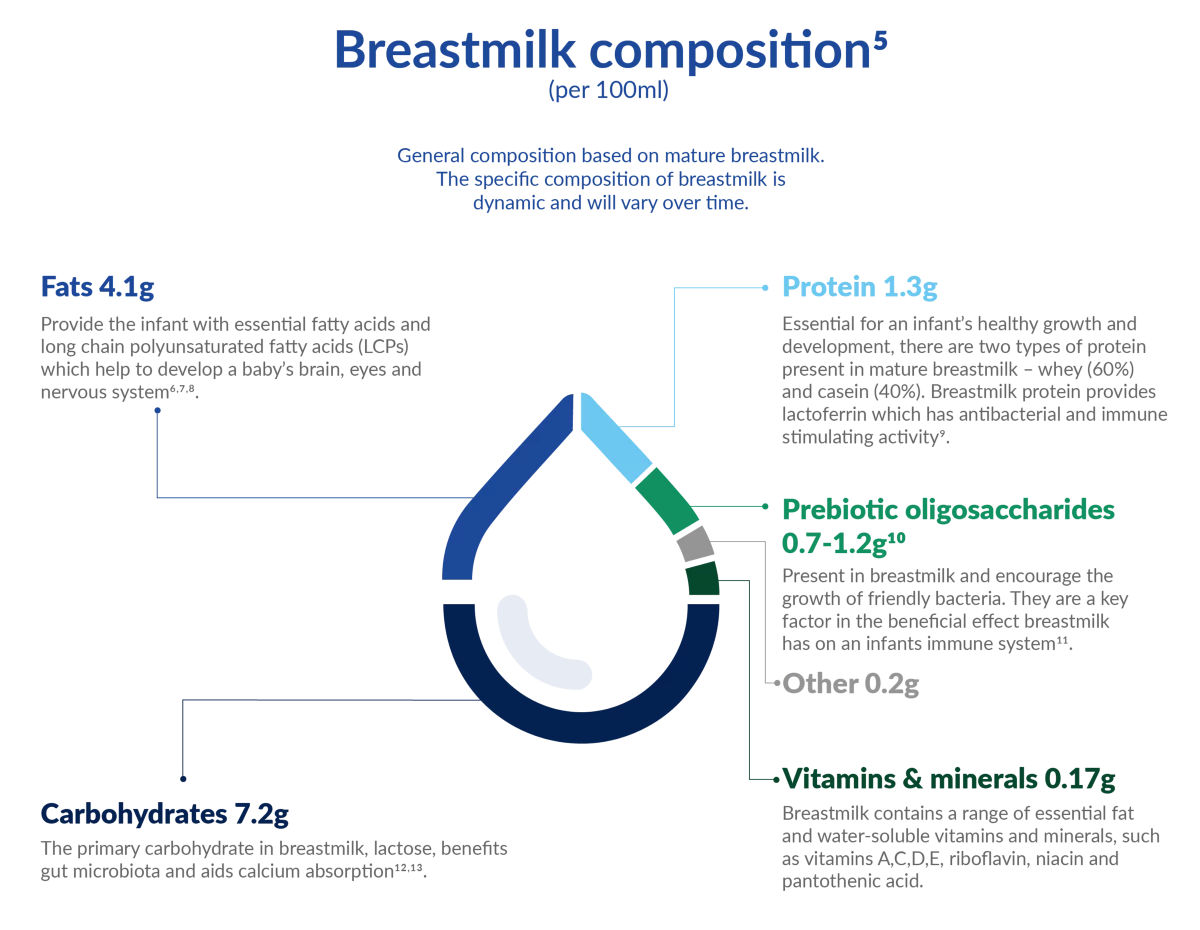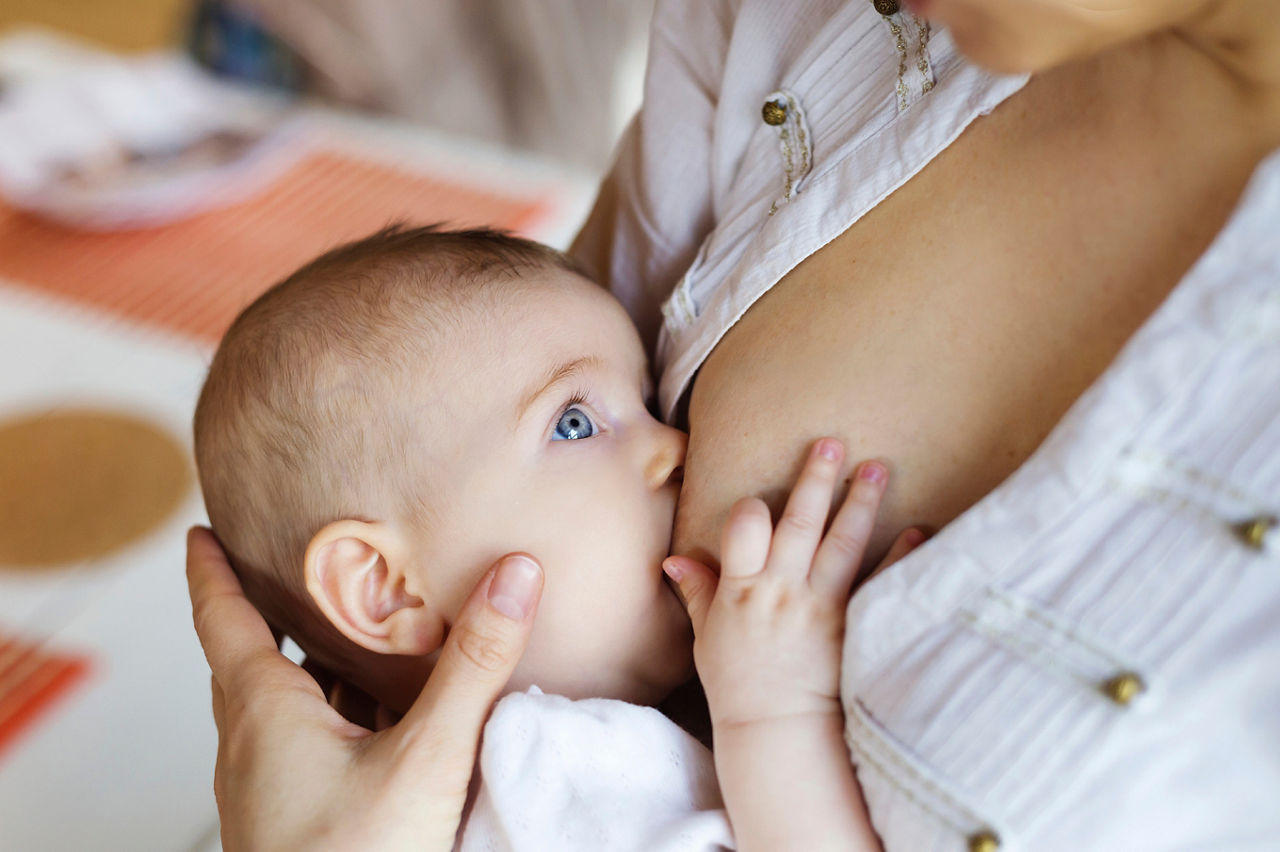Breastmilk is the nutritional ‘gold standard’ of early life nutrition and contains all the essential nutrients required to support an infant’s healthy growth and development¹. As a result, breastfeeding is promoted globally as the optimum method of infant feeding¹, but the UK has one of the lowest rates of breastfeeding in Europe². In the following guide for healthcare professionals we take a look at the importance of breastfeeding and the significant health benefits for mother and infant.
The composition of breastmilk
The composition of breastmilk is highly variable and is adapted to the nutritional needs of an individual infant and will vary over time3,4 The graphic below shows the general composition of breastmilk, which contains all the essential nutrients to support healthy growth and development, including development of the infant’s immune system.

The evidence-based benefits of breastfeeding
Breastfeeding reduces the baby’s risk of developing infections, diarrhoea and vomiting (with fewer visits to the hospital as a result), sudden infant death syndrome, childhood leukaemia, type 2 diabetes, obesity, cardiovascular disease in adulthood and allergic disease14,15. More generally, breastfeeding benefits the infant’s developing immune system, supports development of the infant’s gastrointestinal tract, and helps build a strong emotional bond between mother and baby16,17.
Additionally, breastfeeding has been shown to lower the mother’s risk of breast cancer, ovarian cancer, osteoporosis, cardiovascular disease and obesity, as well as help build a strong emotional bond between mother and baby14.
Breastfeeding reduces the baby’s risk of developing infections, diarrhoea and vomiting (with fewer visits to the hospital as a result), sudden infant death syndrome, childhood leukaemia, type 2 diabetes, obesity, cardiovascular disease in adulthood and allergic disease14,15. More generally, breastfeeding benefits the infant’s developing immune system, supports development of the infant’s gastrointestinal tract, and helps build a strong emotional bond between mother and baby16,17.
Additionally, breastfeeding has been shown to lower the mother’s risk of breast cancer, ovarian cancer, osteoporosis, cardiovascular disease and obesity, as well as help build a strong emotional bond between mother and baby14.
The official advice
The Department of Health (DoH) and the World Health Organisation (WHO) recommend exclusive breastfeeding for the first six months of life, with continued breastfeeding along with appropriate complementary foods up to two years of age or beyond18,19.
The National Institute for Health and Care Excellence (NICE) states: “Breastfeeding contributes to the health of both the mother and child in the short and longer term. Mothers should be made aware of these benefits and those who choose to breastfeed should be supported by a service that is evidence-based and delivers an externally audited, structured programme20.”
Respecting the mother’s right to choose
All women, including those who do not breastfeed, should be supported in their choice and made to feel confident in their relationship with their baby while being provided with practical and emotional support21.
The Royal College of Midwives’ (RCM) latest position on infant feeding (June 2018) states: “We recognise that some women cannot or do not wish to breastfeed and rely on formula milk. They must be given all the advice and support they need on safe preparation of bottles and responsive feeding to develop a close and loving bond with their baby22.”
Supporting the breastfeeding mother23
NICE offers guidance for mothers on infant feeding and advises that culturally appropriate support on breastfeeding should be available to all mothers. Mothers should be encouraged to have skin-to-skin contact with their infants as soon as possible after the birth.
During the antenatal period, mothers should be asked about their feeding intentions, have any questions or concerns about breastfeeding addressed and be reassured that support will be available. Following delivery, from the first feed, women should be offered skilled breastfeeding support (from a healthcare professional, mother-to-mother or peer support).
Advice should cover how to start and continue successful breastfeeding, support with positioning and attachment, assessing successful breastfeeding, expression and storage of breastmilk, and preventing, identifying and treating breastfeeding concerns.
How fathers and partners can support breastfeeding24
Fathers and partners should be helped to understand the benefits of breastfeeding and encouraged to help support a new breastfeeding mother by supporting their partner’s decision to breastfeed and boosting their confidence with encouragement — which can be either verbal, emotional or practical in nature.
Fathers should know how breastfeeding works and be aware of what constitutes normal behaviour in breastfed infants, so they can share in the care of their child while bonding in other ways — through playing, bathing, winding, changing nappies, skin-to-skin contact and carrying the infant in a sling.
Communication is key too, so fathers can listen to and talk honestly with their partner about finding their way with the new infant. It can be a great help to reduce the household chores, so mothers can feed their infants for as long and as often as they need to.
Likewise, taking care of other children in the family can be vital in helping a partner to breastfeed without interruption, especially in the early stages where breastfeeding is becoming established. At the same time, encouraging a partner to eat and drink healthily and regularly ensures the mother will be in peak health during the breastfeeding period.
40 years of early life science
Do you have a question?
Contact our team of experts for guidance on the use and composition of our product range, for support with queries regarding your Nutricia account and sampling service or to get in touch with your local Nutricia representative. We are available Monday to Thursday 9am-5pm and Friday 9am-4pm (except Bank Holidays)

- Spencer R et al. ‘I was meant to be able to do this’: a phenomenological study of women’s experiences of breastfeeding. Evidence Based Midwifery. 2014. 12(3): 83–88
- RCPCH. Position statement: breastfeeding in the UK. The Royal College of Paediatrics and Child Health, May 2018. Available at: https://www.rcpch.ac.uk/resources/position-statement-breastfeeding-uk [Accessed December 2018].
- Hassiotou et al. Maternal and infant infections stimulate a rapid leukocyte response in breastmilk. Clinical and Translational Immunology. 2013. 2(4): e3.
- Powe et al. Infant sex predicts breast milk energy content. American Journal of Human Biology. 2010. 22(1): 50–54.
- Finglas P, et al. McCance and Widdowson’s The Composition of Foods Seventh Summary Edition and updated Composition of Foods Integrated Dataset. Public Health England. Cambridge, September 2014.
- Koletzko B, et al. The roles of long-chain polyunsaturated fatty acids in pregnancy, lactation and infancy: review of current knowledge and consensus recommendations. J Perinat Med. 2008;36:5–14.
- Willatts P, et al. Effect of long-chain polyunsaturated fatty acids in infant formula on problem solving at 10 months of age. Lancet. 1998;352:688–91.
- Birch EE, et al. Visual acuity and the essentiality of docosahexaenoic acid andarachidonic acid in the diet of term infants. Visual acuity and the essentiality of docosahexaenoic acid and arachidonic acid in the diet of term infants. Pediatr Res. 1998 Aug;44(2):201–9.
- Ballard et al. Human milk composition: nutrients and bioactive factors. Pediatr Clin North Am. 2013;60(1): 49–74
- Boehm G, Stahl B. Oligosaccharides from milk. J Nutr. 2007;137:8475–95.
- Boehm G et al. Structural and functional aspects of prebiotics in infant nutrition. J Nutr. 2008;138(9):S1818–28er
- Francavilla R, et al. Effect of lactose on gut microbiota and metabolome of infants with cow’s milk allergy. Pediatr Allergy Immunol. 2012 Aug;23(5):420–7.
- Heyman MB. Lactose intolerance in infants, children, and adolescents. Pediatrics. 2006; 118;1279–86.
- NHS Choices: Your pregnancy and baby guide. Available at https://www.nhs.uk/conditions/pregnancy-and-baby/benefits-breastfeeding/ [Accessed July 2018]
- Kull I et al. Breastfeeding and allergic diseases in infants — a prospective birth cohort study. Arch Dis Child. 2002;87: 478–481
- Matheson MC et al. Breastfeeding and atopic disease: a cohort study from childhood to middle age. J Allergy Clin Immunol. 2007;120(5):1051–7.
- Boehm G et al. Structural and functional aspects of prebiotics in infant nutrition. J Nutr. 2008;138(9):S1818–28.
- World Health Assembly. Global strategy for infant and young child feeding: the optimal duration of exclusive breastfeeding. World Health Organization, 54. 2001.
- Department of Health. Infant Feeding Recommendations. 264898 1P 70K. London: DH, 2004.
- NICE quality standard [QS37]. Postnatal care. Available at: https://www.nice.org.uk/guidance/qs37/chapter/Quality-statement-5-Breastfeeding [Accessed July 2018].
- The evidence and rationale for the UNICEF UK Baby Friendly Initiative standards. UNICEF UK 2013. Available at: https://www.unicef.org.uk/wp-content/uploads/sites/2/2013/09/baby_friendly_evidence_rationale.pdf [Accessed November, 2018]
- The RCM’s updated position statement on infant feeding — what’s new and why? 12 June 2018. Available at: https://www.rcm.org.uk/news-views/rcm-opinion/the-rcms-updated-position-statement-on-infant-feeding/ [Accessed November, 2018]
- NICE clinical guideline [CG37]. Postnatal care up to 8 weeks after birth. Available at: https://www.nice.org.uk/guidance/cg37/chapter/1-Recommendations#infant-feeding [Accessed July 2018].
- First 1,100 days. New Parent Support. Available at: https://www.nct.org.uk/parenting/how-can-dads-and-partners-support-breastfeeding [Accessed July 2018]
Help us provide information most relevant to you
Please ensure your role and areas of interest are up to date.


